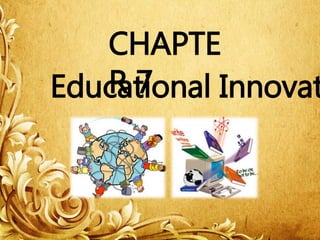
Chapter 7 educational innovation
- 2. Group members 1. นายทินกร เหล่าออง 2. นางสาวสุ นิษา คาสะอาด 3. นางสาวสุ ธาทิพย์ จันทร์ หนองหว้ า 4. นางสาวนิภาพร พลอยโตนด 5. นางสาวเกษดาพร จันทร์ แสน 6. นายธีระยุทธ วันนา 7. นางสาวเพ็ญประภา บุญพิพฒมงคล ั 565050330-5 สาขาชีววิทยา 565050343-6 สาขาชีววิทยา 565050342-8 สาขาชีววิทยา 565050316-9 สาขาเคมี 565050309-6 สาขาเคมี 565050273-1 สาขาคณิตศาสตร์ 565050280-4 สาขาคณิตศาสตร์ นักศึกษาระดับปริญญาโท ชั้นปี ที่ 1 สาขาการศึกษาวิทยาศาสตร์ และเทคโนโลยี
- 5. Task 1 Describe the definition and classification of learning environment.
- 6. Definition of learning environment Learning resources including teacher, technology, parents, folk wisdom and other person as well as media in order to lead to the creation of knowledge.
- 7. The teacher is create the environment that is conducive to learning or knowledge construction of learner by importing the method of technology and innovation or media as well as folk wisdom knowledge to be shared in order to enhance learning. Media + Methods
- 12. Task 2 The use of innovative learning. Accordance with the context of both schools this 3.
- 13. Phremsawas School (โรงเรียนเปรมสวัสดิ์) No Internet Enough use a computer Computer-Assisted Instruction (คอมพิวเตอร์ ช่วยสอน) - Computer Save content By providing an attractive medium. Such as text, graphs, animations - Education Game (บทเรียนชนิดโปรแกรมการศึกษา) Students to compete and learn.
- 14. Mahachai School (โรงเรียนมหาชัย) Limitations on the location and time. Learning on Server (การเรียนรู้ บนเครือข่ าย) - Computer lessons presented. - Lessons presented a Hypertext (แบบข้ อความหลายมิติ ). To help the students learn in meaningful ways. - Can learn anytime.
- 15. Tedsabanwattat School (โรงเรียนเทศบาลวัดธาตุ) Focus on the students construct knowledge for themselves. E-Learning - Used in situations of learning immensely meaningful. - The students can learn at any time and define learn. - Form Interactive Learning (การเรียนรู้ อย่ างมีปฏิสัมพันธ์ ) and Collaborative Learning (การเรียนรู้ ร่วมกัน).
- 16. Task 3 Based on the type of learning innovation in chapter 7, the student present learning innovation that corresponds to the own majors and explain these innovation.
- 17. Major: Biology Biology subjects are abstract by nature.
- 18. The learning innovation for teach biology content Animation A simulation of movement created by displaying a series of pictures, or frames. Source: connect.customer.mcgraw-hill.com
- 19. The learning innovation for teach biology content Computer simulation A program that students can systematically explore hypothetical situations, interact with a simplified version of a process or system, change the time-scale of events, and practice tasks.” Source: http://phet.colorado.edu/th/simulation/gene-expression-basics
- 20. The learning innovation for teach biology content E-Learning Education via the Internet, network, or standalone computer. e-learning is essentially the network-enabled transfer of skills and knowledge. Source: http://sunaddabio.blogspot.com/2013/02/e-learning-e-learning-satellite-web.html
- 21. Advantages of using these innovation in teaching Presents both auditory and visual stimulus to the students. Allowing easier cognitive tagging and encoding of information. Presents material in a way that students are familiar with. Presents material in a way that students are being entertained by
